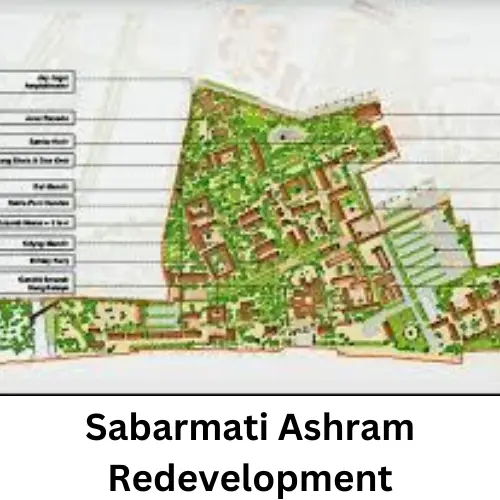Sabarmati Ashram Redevelopment Plan
Redevelopment work is in progress on the Sabarmati Ashram that occupies a special place in India’s fight for freedom. The Sabarmati Ashram Redevelopment Plan which began on the day of the launch by the Prime Minister to commemorate the Dandi March is aimed at the restoration and expansion of this heritage place.
Gandhi Ashram at Sabarmati
Out of all the Ashrams, sabarmati Ashram at Ahmedabad which was founded by Gandhiji in 1917 is the most important Ashram in the Indian freedom struggle. Located at the bank of Sabarmati River the ashram was the epicentre of many movements like the Dandi march, the Champaran Satyagraha and the Non – Cooperation Movement.
Mahatma Gandhi, established five ashrams in his lifetime out of which three were in India. The first was Kochrab Ashram which was situated in Ahmedabad in the year 1915. This, however, was not the case with Sabarmati Ashram, which was Gandhi’s fourth ashram and the one he spent most of his time here so this place became a center of the Indian freedom struggle.
Sabarmati Ashram Built by
Sabarmati ashram was constructed by Mahatma Gandhi for the purpose of personal contemplation, group living and also for encouraging Industrial self reliance among folks. The existing architecture of the ashram has its edifices built in 1917; the architecture reflects the principles of Gandhian para-mounts of simplicity and frugality. These are now being refurbished in a systematic manner as a part of the redevelopment plan with equal regard to the spirit of the ashram.
Redevelopment of Sabarmati Ashram
The present efforts to expand Sabarmati Ashram itself is a combined endeavor by the Union and Gujarat governments intending to turn use the ashram into the global class memorial. This project is restored from an aerial photo in 1949 and the records and histories from the ashram, in this way, the restored pictures are historical.
Key Features of the Redevelopment Plan:
- Expansion and Restoration: The existing five-acre area of the ashram will be expanded to approximately 55 acres. This includes the restoration of all original heritage buildings from Gandhi’s time.
- Mohan to Mahatma Park: A new park will feature an arboretum with trees from all states and Union Territories, symbolizing national unity.
- Herbal Garden and Meditation Hall: A herbal garden shaped in the iconic pose of Gandhi walking with his staff, along with a meditation hall and ‘dhyan kendra’ (meditation center), will be established to enhance the spiritual experience for visitors.
- Relocation of Residents: Families currently residing in the ashram will be relocated to facilitate the expansion while maintaining the integrity of the site.
Kochrab Ashram: The Beginning of Gandhi’s Journey in India
Prime Minister also launched the redeveloped Kochrab Ashram in Ahmedabad, ahead of the Sabarmati Ashram redevelopment project. Kochrab Ashram, Gandhi’s first ashram in India was established in 1915 thus setting a pace for Gandhi to lead India to the path of freedom.
Historical Movements Launched from Sabarmati Ashram
The Sabarmati Ashram was not just a residence for Gandhi but the starting point for several key movements that shaped India’s fight for freedom:
- Dandi March (1930): Gandhi began the historic Salt March from this ashram, challenging British salt laws.
- Champaran Satyagraha (1917): Gandhi’s first act of civil disobedience in India, advocating for the rights of indigo farmers.
- Kheda Satyagraha and Ahmedabad Mills Strike (1918): Movements focused on farmers’ and workers’ rights.
- Khadi Movement (1918): Promoted self-reliance through the use of hand-spun cloth.
- Rowlatt Act and Khilafat Movements (1919): Protests against repressive laws and advocating for Hindu-Muslim unity.
- Non-Cooperation Movement (1920): A mass protest against British rule.
Conclusion
The new master plan of development of Sabarmati ashram is a very good attempt towards the architectural conservation and continuity of the architectural history of a part of Gandhi’s life. By preserving and enlarging the structures and area, the project envisages the possibility of preserving the memory of Gandhi and at the same time making the visitor get acquainted with and receive inspiration for further achievements. When this transformation is being undertaken for the ashram, it will remain a symbol of Gandhi’s policy of non-violence, simplicity, and truth.
